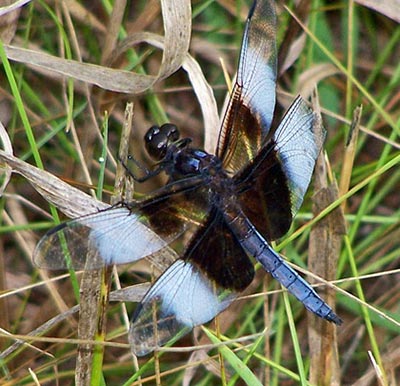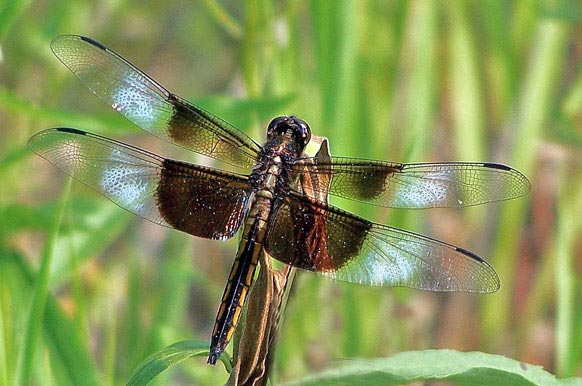Howdy, BugFans,
Today we take to the air with three big dragonflies that belong to a group called the “King Skimmers.” Represented by 103 species in North America, the Skimmer family (Libellulidae) contains our most common and conspicuous dragonflies—Pennants, Meadowhawks, Gliders, Corporals, Pondhawks, Whitefaces, Saddlebags, Skimmers and the like. According to Sydney Dunkle in Dragonflies through Binoculars, they are colorful but not metallic, often have patterned wings, and their eyes contact each other at the top of their head. They are often sexually dimorphic, with colorful males and not-so-colorful females. Dunkle calls the King Skimmers (the genus Libellula) “the quintessential dragonflies”—strong fliers, feisty, territorial, stout-bodied, some with white markings on their wings. The word pruinose rears its head again, as the abdomens of males of today’s dragonflies develop some degree of “hoariness” (due to the production of waxy scales) as they age. Compared to the damselflies of recent BOTW fame, these are giants; a few damselflies could easily sit on one of their wings.
A female Skimmer doesn’t have an ovipositor like females of other dragonfly groups so instead of “inserting” her eggs into the water, she jolts them from her abdomen by smacking its tip on the water surface. Males generally “hover-guard” while their ladies are thus engaged. Widow skimmers, Whitetails and 12-spots prefer shallow ponds, lakes, and very slow streams with lots of organic muck on the bottom, though they may forage far from water. Submerged aquatic plants are great, but they don’t care for floating duckweed leaves in the water. They are effective predators of mosquitoes and other aerial insects.
Here are three “black-and-white” King Skimmers that are gracing the skies here in God’s Country, starting with the fanciest and moving to the simplest. All have dark eyes; the males are pretty distinctive, but the females can be a bit confusing. Like most dragonflies, the information sites on the internet are logarithmically outnumbered by the zillions of happy photographers out there stalking dragonflies, and there is a lot of dragonfly merchandise available.
12-Spotted Skimmer
The 12-Spotted Skimmer (Libelula pulchella) (pulchella means “little beauty” but their bodies are about 2” long) used to be called the 10-spotted skimmer by people who were counting the dark spots instead of the white ones. The BugLady frequently sees them perched on last year’s weed stalks in her grassy field, far from the waterfront properties where they woo and win female 12-spots. When they’re chilly, they face into the sun and raise their abdomens, to maximize exposure.
[metaslider id=5116]
Males characteristically fly, stop and hover, and then chase off in a different direction. Even when disturbed, they will return to the same sentinel post. They patrol a territory, chasing off dragonflies of any species and psyching out other 12-spot males by flying vertical loop-the-loops around them. Some of the Atlantic Coast 12-spots migrate in fall.
How to ID them? Males, females and juveniles all have 12 dark spots on their wings. Males add 10 white spots. The wing spots of female 12 spots are similar to those of female Whitetails, and they both also have dark abdomens with a light stripe on each side. In female 12-spots, that light line is a yellow, more-or-less solid line.
Common Whitetail
Common Whitetails (Libellula (sometimes called Plathemis) lydia) are the most blatant of the three. They’re just under 2” long, and the male’s spectacular white (pruinose) abdomen (powder blue in younger males) contrasts with his large dark wing spots (one on each wing). Females can be distinguished from female 12-spots by the broken/zig-zag, not continuous, white/light line along each side of her abdomen. Juvenile males’ bodies are marked like females, and as they age, the priunosity covers the abdominal markings.
[metaslider id=5113]
Dunkle says that adults are attracted to the dark of mud, where they often perch. Whitetails also sun themselves. Males fiercely defend a territory about 12 yards long over open water and pond edges. Dominant males display their bright tails; submissive males lower theirs. Females lay their eggs in the shallows where there is a lot of submerged vegetation (the habitat their naiads (larvae) prefer), and their naiads are tolerant of low dissolved oxygen in the water. If she wants to lay eggs on his prime real estate (up to 1000 eggs in a sitting, repeated every other day), she must mate with the owner. According to Legler in his wonderful Dragonflies of Wisconsin, a naiad that is ready to transform into an adult may crawl as far as 150’ from its watery home before emerging.
Widow Skimmer
The exquisite Widow Skimmer (Libellula luctuosa) is the BugLady’s favorite of the three. Widows are so named because they oviposit without the protection of their mates (one source reports that luctuosa means sorrowful, which the BugLady cannot verify, and compares their wing color to mourning crepe). They are always flying up unexpectedly out of the tall grasses as the BugLady explores her field.
[metaslider id=5106]


At almost 2 ¼” long, they are the largest of the three. In both sexes, the base of the wing is brown. Males have big bluish-white spots next to the brown, fading to clear-ish patches at the wing tips. The center of the female’s abdomen is a black stripe, bordered on each side by broad, gold stripes that merge at the thorax like an inverted V. Juveniles start out looking like females, and the juvenile male’s abdomen gradually changes color.
When there aren’t many Widows around, males each defend their own territories (up to 250 square yards), but the territories move daily. Defense of their home turf can be a contact sport. With overcrowding, a dominant male emerges and he gets all the ladies. In dense populations, the male will guard his female as she lays eggs, lest she gets raided by an intruder (who will discard his rival’s reproductive material and replace it with his own).
Besides the Legler and Dunkle books, the BugLady recommends Dragonflies of the North Woods by Kurt Mead and the Stokes Beginner’s Guide to Dragonflies.
The Bug Lady